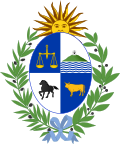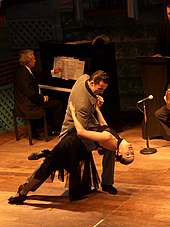Culture of Uruguay
This article needs additional citations for verification. (November 2020) |
| This article is part of a series on the |
| Culture of Uruguay |
|---|
 |
|
Uruguay Portal |
|
|
The culture of Uruguay is diverse since the nation's population is one of multicultural origins. Modern Uruguayan culture is known to be heavily European influenced, mostly by the contribution of its alternating conquerors, Spain and Portugal, and from the large numbers of immigrants who arrived in the country from the 19th century onwards.
From the year 1858 to 1950 large waves of European immigrants began arriving to Uruguay, with the majority of the immigrants coming from
Visual arts
Painting and sculpture

Well-known Uruguayan painters include realists such as

Well-known sculptors include realists
Architecture
Due to European migration, new forms of art and design started to enter during the formation of Uruguay. Many buildings in Uruguay are European influenced, for example, the Palacio Salvo was designed by Italian architect Mario Palanti.
Many well recognized architects around the world are Uruguayan. Some famous Uruguayan architects include Juan Antonio Scasso, Juan Giuria, Leopoldo Artucio, Eladio Dieste, and Carlos Ott.
Modern society
Immigration

Among the several peoples who settled Uruguay and formed the backbone of its society must be highlighted
Languages
Spanish is the official language of Uruguay, and is spoken by almost all of the population. The Spanish spoken in Uruguay is more commonly known as Rioplatense Spanish, the same Spanish that is spoken in parts of Argentina. Rioplatense Spanish is known by many in South America as Spanish spoken with an Italian accent, due to Italian effects on modern day Uruguayan society. Minority languages in Uruguay include Italian, French, German, Hebrew, and other European languages. English is also considered a minority language, though it is more used in the business world. Other languages include Portuguese and Portuñol, a mixture of Spanish and Portuguese (pidgin language). Both are present in northern regions near the Brazilian border.
Gestures
Uruguayan gestures are mostly adopted from
Popular culture
Music

Uruguayans enjoy music such as
Motion pictures
The first Uruguayan motion picture is "Carrera de bicicletas en el velódromo de Arroyo Seco". The film was directed by Félix Oliver, the pioneer of cinematography in Uruguay. The best reviewed Uruguayan movie is the 2004 film, Whisky. Directed by Juan Pablo Rebella and Pablo Stoll, with a starring cast of Andrés Pazos, Mirella Pascual, and Jorge Bolani, it was well-received by film critics.
Smoking
Roughly 1/3 of Uruguayan adults smoke tobacco, according to Uruguayan research groups.[2] On March 1, 2006, a law went into effect banning smoking in all enclosed public spaces in Uruguay, including restaurants and bars, among the toughest smoking bans worldwide and the strictest in Latin America. The penalty for businesses that allow smoking is a fine of roughly US $1,100 or a three-day closure. One opinion poll found that 70% of smokers supported the ban.[3] Current President of Uruguay in that year, Tabaré Vázquez, was a medic doctor specializing in cancer treatment.
Literature

One of Uruguay's most famous works of
The Generación del 45 (Generation of '45) were of group of writers, mainly from Uruguay, who were famously known to have an influence on literature and culture of the region. Well-known writers belonged to this group such as Mario Benedetti, Amanda Berenguer, Juan Carlos Onetti, Mauricio Müller, Humberto Megget, Armonía Somers, Idea Vilariño, Emir Rodríguez Monegal, Carlos Maggi, Zenobia Camprubí and among others.
Religion
Since 1919, church and state have been separated, and the constitution, as revised in 1966, guarantees religious freedom. The largest religion in Uruguay are the
Cuisine

Uruguayans consume a large amount of beef,[4] primarily at gatherings known in the continent as the asado. The parrillada (beef platter), chivito (a substantial steak sandwich), and pasta are the national dishes. Uruguayan cuisine is greatly influenced by Italian cuisine, due to the large number of immigrants who arrived in the country in the 19th and 20th centuries.[5]
Other Uruguayan dishes include morcilla dulce (a type of
Wine
Plantings of
Sports

Sports in Uruguay have been a key element to the culture since the nation's independence.
Football (Spanish: fútbol) is the most popular sport in Uruguay. Uruguay has won an Olympic gold medal in 1924, and another one in 1928, which were considered the most important tournaments in football, before the FIFA World Cup began in 1930, hence the four stars on the Uruguayan jersey. The first World Cup, which Uruguay won,[8] was held in 1930 in Montevideo. The Estadio Centenario was built for the World Cup, and serves to this day as the country's main football stadium.
Uruguay also won the World Cup in
Uruguay has the most Copa América titles, the most important football tournament in the South American region. Uruguay currently has 15 titles to their name, the most recent being the 2011 Copa América hosted by Argentina.
Uruguay has two major clubs,
Uruguayans are internationally known in the football world and have produced some of the biggest names of the sport. Some names include:
- Enzo Francescoli
- Juan Alberto Schiaffino
- Hector Scarone
- Diego Forlán
- Luis Suárez
- Álvaro Recoba
- Jose Nasazzi
- Diego Godín
- Edinson Cavani
- Diego Lugano
- Alcides Ghiggia
- Antonio Pacheco D'Agosti
- Ladislao Mazurkiewicz
- Paolo Montero
Other popular sports in Uruguay include
.References
- ^ Felipe Arocena. "The contribution of immigrants to Uruguay" (PDF) (in Spanish). Multiculturalismoenuruguay.com. Archived from the original (PDF) on 4 March 2016. Retrieved 21 October 2013.
- ^ http://www.latimes.com on 2007-02-17
- ^ "Uruguay curbs smoking in public". News.bbc.co.uk. 1 March 2006. Retrieved 16 October 2017.
- ^ "Uruguay: world's leading consumer of beef with 58.2 kilos per capita per annum". En.mercopress.com. Retrieved 16 October 2017.
- ^ Dazzo, Rino (2021-05-08). "Carne sí, ma sempre con pasta, milanesa, fainá, tallarines con tuco e il 29 di ogni mese, gnocchi". Gente d'Italia (in Italian). Retrieved 2023-11-15.
- ISBN 0-15-100714-4
- ISBN 0-19-860990-6
- ^ World Soccer Archived 2005-08-19 at the Wayback Machine

